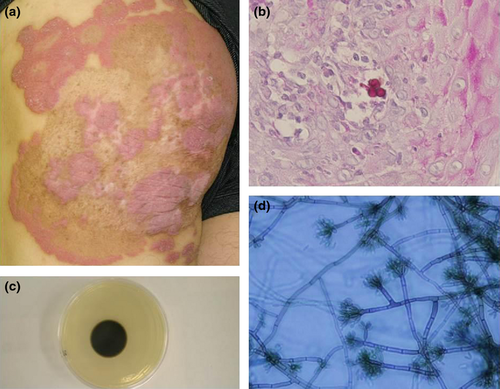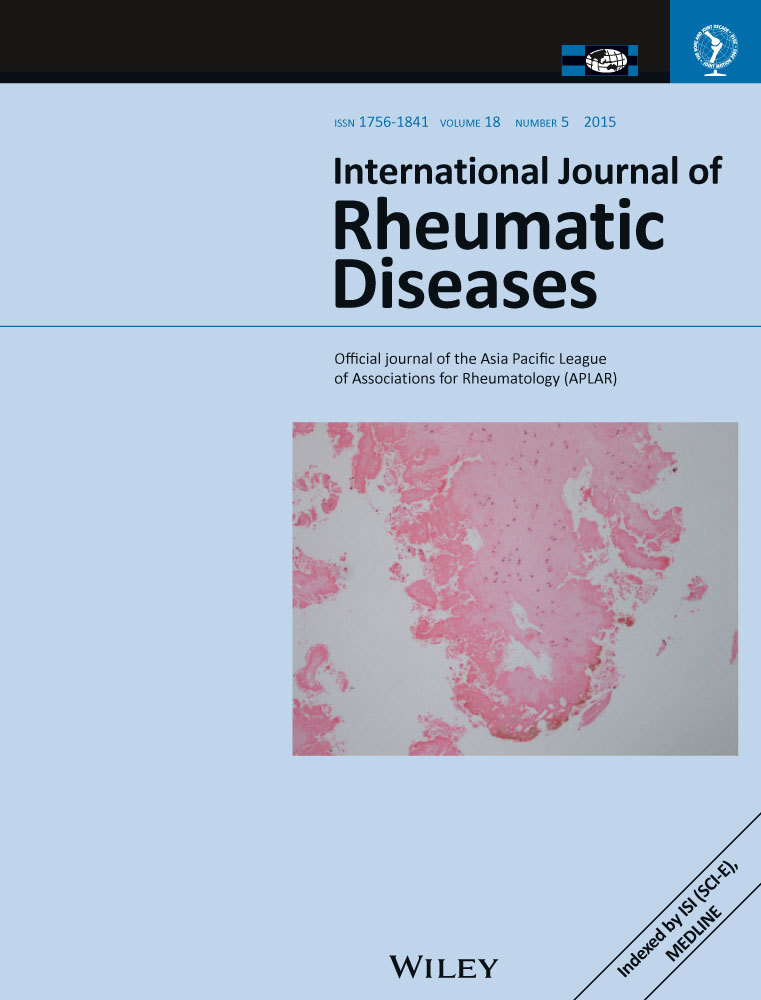A case of chromoblastomycosis caused by Fonsecaea pedrosoi in a patient with rheumatoid arthritis
Dear Editor,
A 53-year-old man was referred to our hospital, complaining of skin lesions on his right buttock. He first noticed a skin lesion sized about 1 cm in diameter 20 years ago, but only began to spread after 10 years. His past medical history included rheumatoid arthritis (RA) for 9 years and diabetes mellitus (DM) for 10 years. His RA was treated with prednisolone (5 mg/day) and non-steroidal anti-inflammatory drugs (NSAIDs) at the initial visit to our department. Although he had been treated with prednisolone shifting between 4 and 10 mg per day, which could not completely suppress the diseases activity, prednisolone dose was not increased furthermore because he had DM. His DM was well-controlled with insulin administration. Physical examination showed a reddish keratotic lesion consisting of multiple keratotic nodules coalescing into verrucous plaques on the right buttock (Fig. 1a). A biopsy specimen revealed pseudocarcinomatous irregular epidermal hyperplasia, and granulomatous inflammation consisting of neutrophils, lymphocytes, histiocytes and giant cells in the dermis. Periodic acid-Schiff (PAS) stain revealed sclerotic cells (Fig. 1b). Examination of the mycological culture on Sabouraud's dextrose agar showed growth of colonies with black surfaces (Fig. 1c). Lactophenol cotton blue mount of the colony revealed brown septate branching hyphae with Fonsecaea type of sporulation (Fig. 1d). For molecular biological analysis, DNA was extracted from the cultured colonies, and the base sequence of internal transcribed spacer (ITS) was identified, which resulted in a 99.6% match with Fonsecaea pedrosoi. Results of laboratory examination revealed anemia, liver and renal dysfunction, elevated levels of β-D glucan (6.1 pg/mL), and increased levels of rheumatoid factor (388 IU/mL; normal < 15), anticyclic citrullinated peptide antibodies (36.5 U/mL, normal < 4.5), and matrix metalloproteinase-3 (190 ng/mL, normal < 120), indicating that his RA was in an active state. A human immunodeficiency virus (HIV) test was negative. He was treated with systemic terbinafine (125 mg/day for the initial 2 months and 250 mg for an additional 4 months), followed by itraconazole (100 mg/day) for 1 month; however, this induced a drug eruption. Therefore, we administered voriconazole (400 mg/day) for 5 months and the patient went into remission. Local hyperthermia was also applied during all the courses.

Chromoblastomycosis is a rare deep fungal infection, clinically characterized by verrucous plaques and nodules on the legs,1-3 that is most commonly found in tropical and subtropical countries. Chromoblastomycosis is usually found in soil, wood, and rotting vegetation and is infected primarily via percutaneous macro- or micro-traumatic inoculation. It is therefore often seen in farmers and agricultural workers. Fonsecaea pedrosoi is the most frequent cause, and other lesser etiologic agents include Cladosporium carrionii, Phialophora verrucosa, Rhinocladiella aquaspersa, Fonsecaea compacta, Exophiala dermatitidis, Exophiala jeanselmei, Exophiala spinifera and Botryomyces caespitosus.
We described herein a case of chromoblastomycosis due to Fonsecaea pedrosoi in the Tohoku area (northern area of Japan). Our patient was suffering from RA and had been treated with systemic prednisolone for a long time. Cutaneous lesions associated with RA are various4 and patients with RA have an increased risk of infections.5 Superficial dermatophytic infections such as tinea pedis, onychomycosis and candidiasis are commonly seen.6, 7 However, deep fungal infection is also seen and the fact that deep mycosis can occur in RA patients should be widely recognized. In particular, caution is necessary before or during anti-tumor necrosis factor (TNF)-α therapy for RA. Furthermore, the patient had DM, also a condition susceptible for infection. Consistent with the development of RA as well as DM, skin lesions were deteriorated. Thus, we conclude that active rheumatic conditions, long-term prednisolone treatment and DM may be relevant to the development of deep fungal infection in this case.
Therapeutic options include systemic administration of itraconazole, ketoconazole, fluconazole, terbinafine, 5-fluorocytosine and amphotericin B; however, they are sometimes difficult to treat, especially with widespread lesions. Surgical treatment is sometimes adopted in combination with systemic chemotherapy, cryotherapy and local hyperthermia.
Conflicts of Interest
None declared.
Funding Sources
None.




